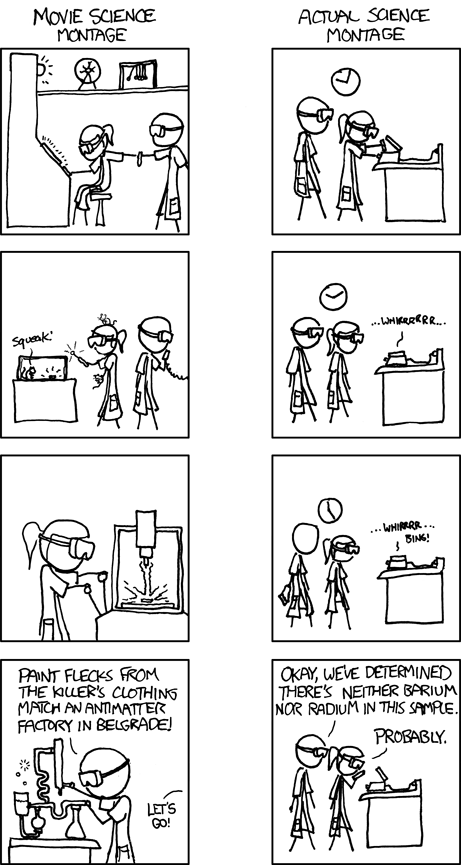
August 26, 2018, by Philip Moriarty
Physics in Film: The Good, The Bad and The Ugly
This is a guest post from PhD researcher Chris Morley, whose work focuses on Bose-Einstein condensates and associated quantum technologies. Chris outlines some bugbears he has with the use and abuse of physics in films…
I do not have a particularly refined taste in films, or TV for that matter. My favourite film franchise is the super charged, post-apocalyptic, car crashing carnage of Mad Max. Not exactly intellectual cinema (though, judging by the number of Oscars the most recent instalment of the franchise, Fury Road, took home, perhaps I have a more refined taste than I thought). There is one thing I do tend to be oddly picky about when it comes to films though, and that’s the physics.
Just as how an avid fan of a book watches the TV adaptation and thinks that’s wrong, that doesn’t happen, this bit is completely different, I find I have a similar problem when it comes to dodgy physics in films. It doesn’t ruin the experience for me, but I find I spend the rest of the film taking the mickey out of it. The most recent example of this was when I was watching Spectral, a Netflix original film. It started out as fairly standard sci-fi fare; America is involved in a war in insert name of fictional eastern European country here, when they run into ghost-like beings capable of freezing people solid with a single touch. The tide of the battle turns when the stereotypical scientist/engineer hero suddenly realises: they’re not ghosts at all, they’re Bose Einstein Condensates!
I buried my head in my hands at that stage; my research as a PhD student is based around Bose Einstein Condensates (BECs) and cold atom clouds and, in particular, how they can be used in future, so-called, Quantum 2.0 technologies. BECs are an incredible bit of physics: bosons cooled to temperatures just above absolute zero. They exist at temperatures colder even than outer space, which sits at a practically tropical 2.7K compared to the few hundreds of nano-kelvin typical in BECs. At this point, given the right conditions, the bosons, not being bound by the laws of the Pauli Exclusion Principle, form a quantum object composed of many atoms.
This doesn’t tell you why this spoilt the film for me though. The thing is BECs are rather fragile. They are created in high vacuum, lest the fast-moving background gas smash apart the atoms we are carefully collecting in the trap. Yet, unless my memory fails, none of the soldiers in Spectral are wearing breathing apparatus, or pressure suits that would suggest the whole film takes place at such high vacuum. So how are the BEC ghosts so happy to zip around through an active war zone, seemingly impervious to bullets, shrapnel and the even more deadly (to a BEC anyway) AIR they happen to be in.
In fairness I’m probably being overly harsh to Spectral here. It’s a fairly well-produced film, and an entertaining watch. This is also not the only film I’ve watched to fall into this folly, and I suspect I’m not the only physics student to experience this. It seems that for every series like The Expanse, where space ships are depicted as having to continually accelerate to reproduce Earth’s cosy 1G of gravity, there is a film like 2012 (See Dara O’Briain’s famous “The Neutrinos *sniff* have gone off” sketch for a significantly funnier effort at calling out this physics faux pas than I could manage). And don’t even get me started on Call of Duty:Modern Warfare 2, the video game which features a nuclear bomb detonating in Earth’s upper atmosphere that somehow manages to destroy the ISS with the shockwave. To quote one of my fellow A Level students at the time: “So if we model the explosion as a soundwave in 1D, then we still have the problem that it propagates through a medium of nothing …”
No comments yet, fill out a comment to be the first

Leave a Reply